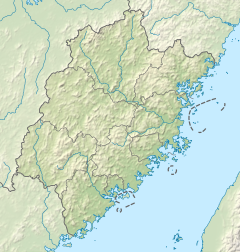Jiuqu Xi
| Jiuqu Xi Jiuqu River | |
|---|---|
 View from the river | |
| Nickname(s) | Nine-bend River |
| Native name | 武夷山 |
| Location | |
| Country | China |
| Region(s) | Fujian and Jiangxi |
| Physical characteristics | |
| Source | |
| • coordinates | 27°49′16″N 117°42′11″E / 27.82101354905567°N 117.70295688329412°E |
| Mouth | |
• coordinates | 27°38′29″N 117°58′09″E / 27.641379294919663°N 117.96927793816394°E |
| Length | 60 km |
| Official name | Mount Wuyi |
| Type | Mixed |
| Criteria | iii, vi, vii, x |
| Designated | 1999 (23rd session), modified 2017 |
| Reference no. | 911bis |
| Region | Asia-Pacific |
| Jiuqu Xi |
|---|

The Jiuqu Xi River (transl. Nine-bend River; also Jiuqu River) is the river rising in the Wuyi Mountains or Wuyishan (Wǔyí Shān), formerly known as Bohea Hills in early Western documents. The river and the mountain range are located in the prefecture of Nanping, in northern Fujian province, near the border with Jiangxi province, China. The region is known worldwide as a refugium for several rare and endemic plant species, its river valleys and the abundance of important temples and archeological sites, earning the area a UNESCO World Heritage Site status.[1]
The Jiuqu Xi River is about 60 kilometers long, meandering in a deep gorge among these hills. In most places, it is a slow, shallow stream navigable only by small craft like rowboats and canoes. However, the river narrows at one point to just a few meters but a depth of 80 metres (260 ft).[2]
See also
[edit]References
[edit]- ^ "Mount Wuyi". UNESCO World Heritage Centre. United Nations Educational Scientific and Cultural Organization. Retrieved 9 Apr 2021.
- ^ "Wooed by Wuyishan". The Ninjinger.
External links
[edit]- Description of natural features Archived 2007-03-13 at the Wayback Machine



